Arizona might conjure images of vast deserts and towering saguaros, but tucked away in its diverse landscapes are hidden oases featuring breathtaking waterfalls. Imagine trading the dry heat for the cool mist of a cascade plunging into a turquoise pool!
Embarking on a waterfall hike in Arizona is an adventure that rewards you with unforgettable scenery and a refreshing escape. Whether you’re an experienced trekker or a family looking for a splash of fun, there’s a waterfall trail waiting for you. Let’s dive into some of the most spectacular waterfall hikes the Grand Canyon State has to offer.
The Legendary Falls of Havasupai
Deep within a side canyon of the Grand Canyon, on the Havasupai Reservation, lie some of the world’s most famous waterfalls. Accessing this paradise requires planning and a permit, but the experience is truly once-in-a-lifetime. The journey itself, descending into the canyon, feels like stepping into another world.
1. Havasu Falls
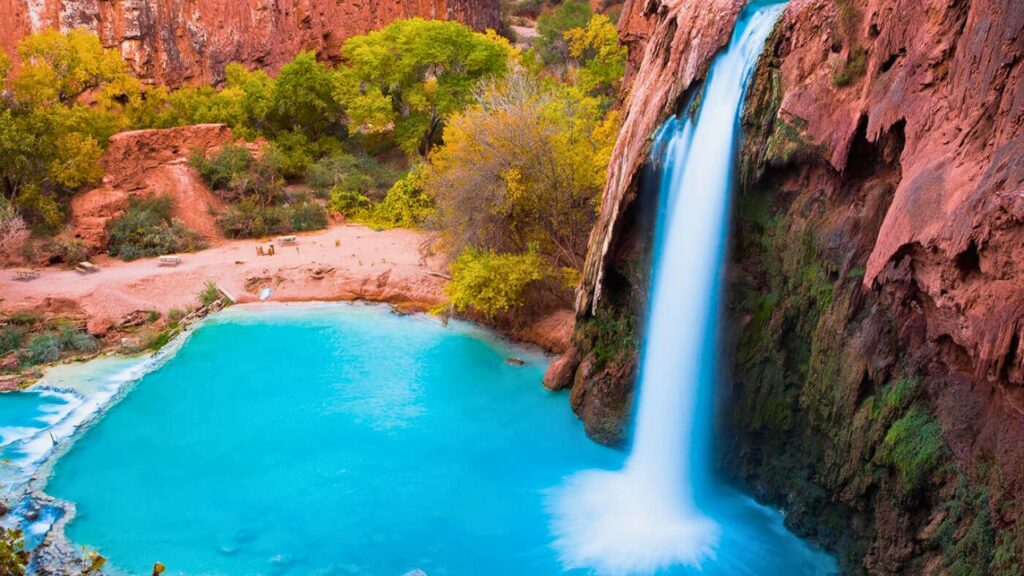
- The Icon: Often the image that comes to mind when thinking of Arizona waterfalls, Havasu Falls is simply spectacular. Picture vibrant blue-green water plunging nearly 100 feet over rust-red travertine cliffs into a series of idyllic pools. The roar of the water is a sound you won’t soon forget.
- The Hike: Getting here is a strenuous 10-mile trek (one way) to the Havasupai campground, followed by another mile to the falls. It’s a significant undertaking, best suited for experienced hikers.
- Best Time to Visit: Aim for early Spring (March-May) or late Fall (September-November) to avoid extreme summer heat.
- Insider Tip: Spend at least a couple of nights camping to fully appreciate the area and explore the other nearby falls without rushing. Permits are required and notoriously hard to get, so plan far in advance!
2. Mooney Falls
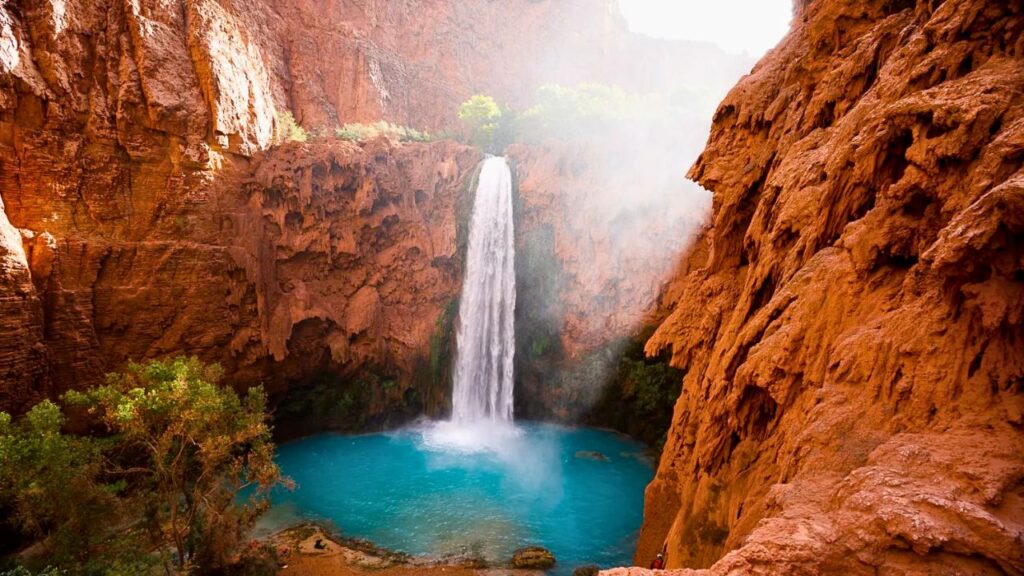
- The Giant: Prepare to be awestruck by Mooney Falls, the tallest of the main Havasupai waterfalls, cascading an impressive 200 feet. The scale is immense, and the mist can be felt from quite a distance.
- The Descent: Reaching the base involves a challenging, near-vertical descent using chains, ladders, and carved steps in the cliffside. It’s an adrenaline rush but requires sure footing and confidence. Gloves are highly recommended for grip.
- The Hike: It’s about a 1.5-mile hike from the campground, but the technical descent is the main challenge.
- Anecdote: Standing at the base, feeling the spray and hearing the thunderous power of Mooney Falls, is humbling. It makes the tricky climb down completely worth it!
3. Beaver Falls
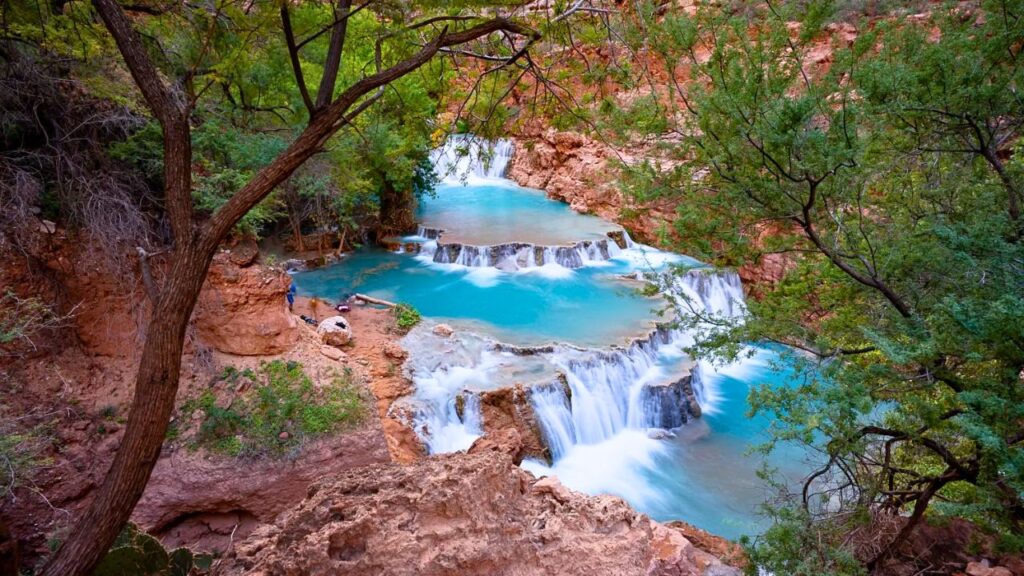
- Terraced Beauty: Further downstream from Mooney Falls lies Beaver Falls, a stunning series of cascading, terraced pools. It’s less about a single dramatic plunge and more about a wide area of smaller falls spilling over limestone, creating perfect swimming holes.
- The Hike: This adds another 4 miles (one way) to your trek from Mooney Falls (or about 8 miles round trip from the campground). It involves creek crossings and some scrambling, making it a moderate to difficult addition to your Havasupai adventure.
- Worth the Effort: Many visitors say Beaver Falls is their favorite spot due to the tranquil, spread-out nature and ample swimming opportunities. It feels like discovering a hidden water park sculpted by nature.
4. Navajo Falls (Upper & Lower) & Fifty Foot Falls
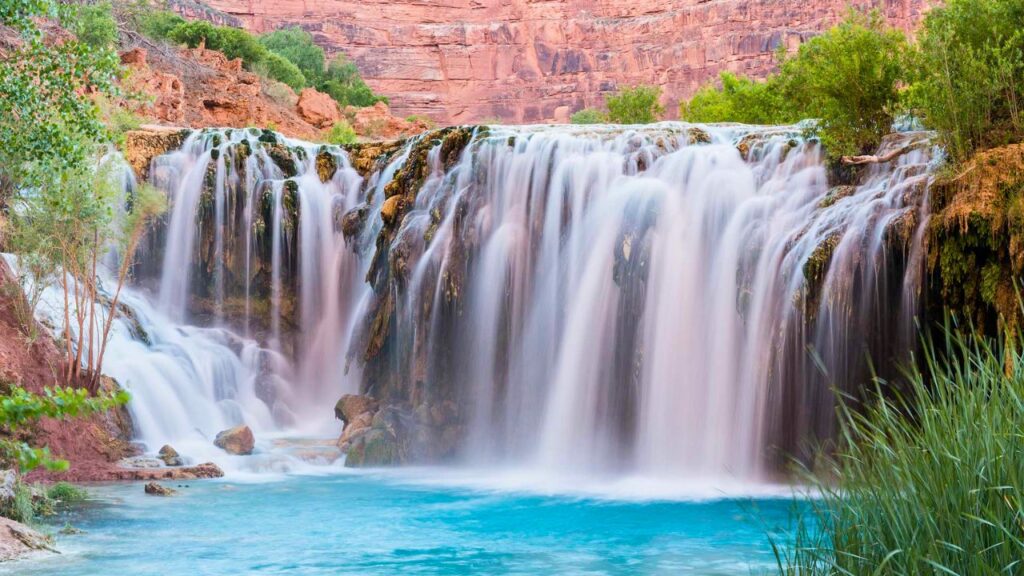
- Newer Additions: These falls were significantly altered or created by flash floods years ago. Navajo Falls now consists of Upper and Lower sections, offering wider cascades and lovely swimming areas closer to the campground than Havasu Falls. Fifty Foot Falls is another delightful spot for a dip.
- Accessibility: They are relatively easier to reach from the main trail or campground compared to Mooney and Beaver Falls.
Gems Near the Mogollon Rim & Central Arizona
Central Arizona, particularly around the Mogollon Rim, hides some delightful waterfall hikes accessible without the intense permit lottery of Havasupai.
1. Fossil Creek Falls
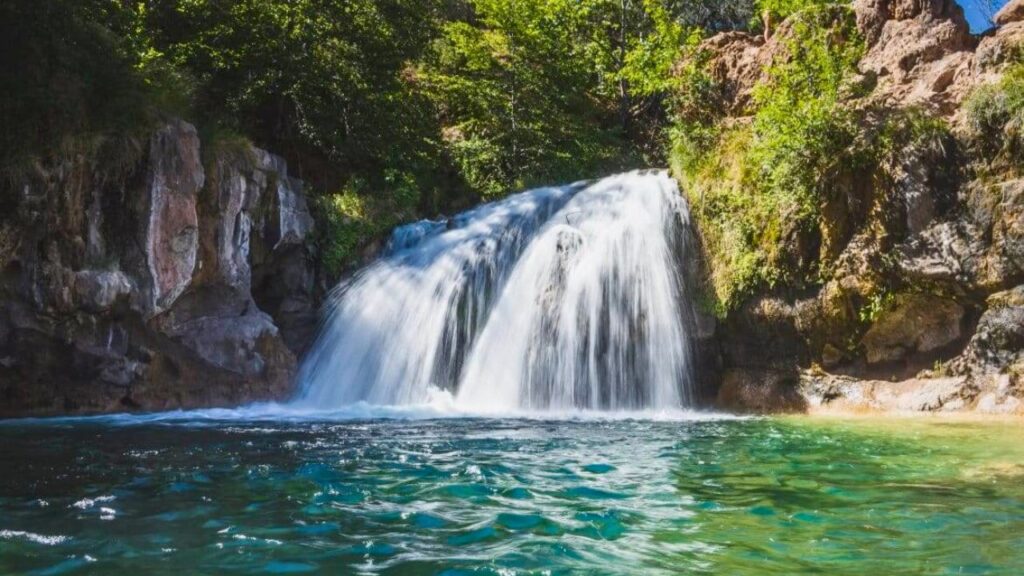
- Turquoise Paradise: Famous for its stunningly clear, turquoise water (thanks to travertine minerals), Fossil Creek is a designated Wild and Scenic River area. The main waterfall plunges about 25 feet into a deep, inviting pool perfect for swimming.
- The Hike: The most direct route is a 1-mile hike (one way) down a steep trail to the main falls. It’s short but can be strenuous on the way back up.
- Location: Near Camp Verde/Pine, Arizona.
- Permit System: Access to Fossil Creek is seasonal (typically April 1st – October 1st) and requires a timed-entry permit booked in advance due to its popularity. This helps manage crowds and protect the sensitive environment.
- Experience: Floating in that cool, clear water on a hot Arizona day, surrounded by canyon walls, feels like pure bliss.
2. Horton Creek Trail
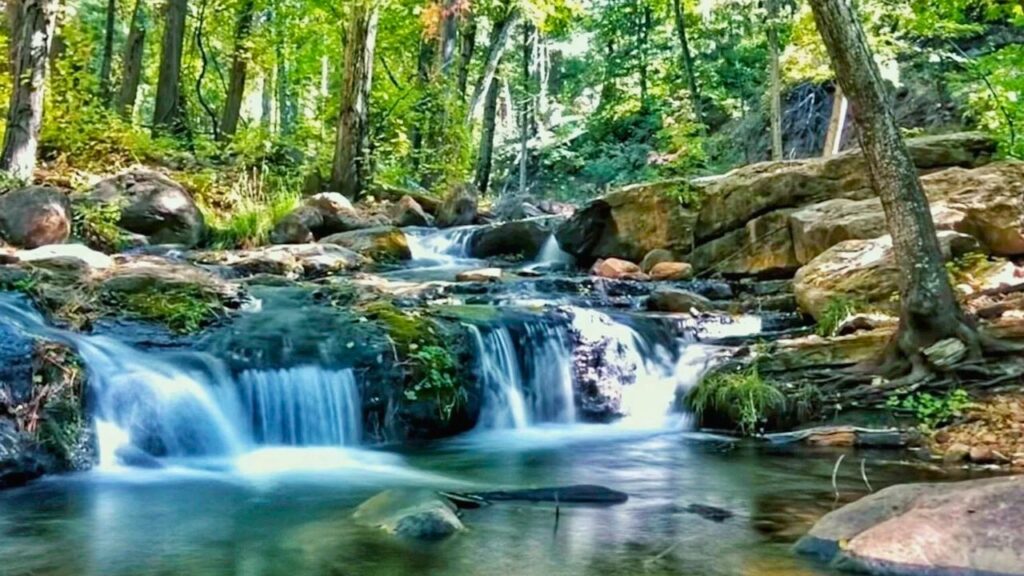
- Shaded Creekside Walk: This trail near Payson doesn’t lead to one massive waterfall but follows Horton Creek through a beautiful, shaded forest. You’ll encounter numerous small cascades and springs bubbling directly out of the hillside, including the picturesque Horton Springs.
- The Hike: It’s a relatively gentle, mostly shaded 8.6-mile round trip hike. The constant presence of water makes it pleasant even on warmer days.
- Best Time to Visit: May through October offers the best conditions.
- Vibe: It’s less about a dramatic destination and more about the journey – a peaceful walk alongside a babbling creek, perfect for reflection and enjoying nature’s smaller wonders.
3. Sycamore Falls
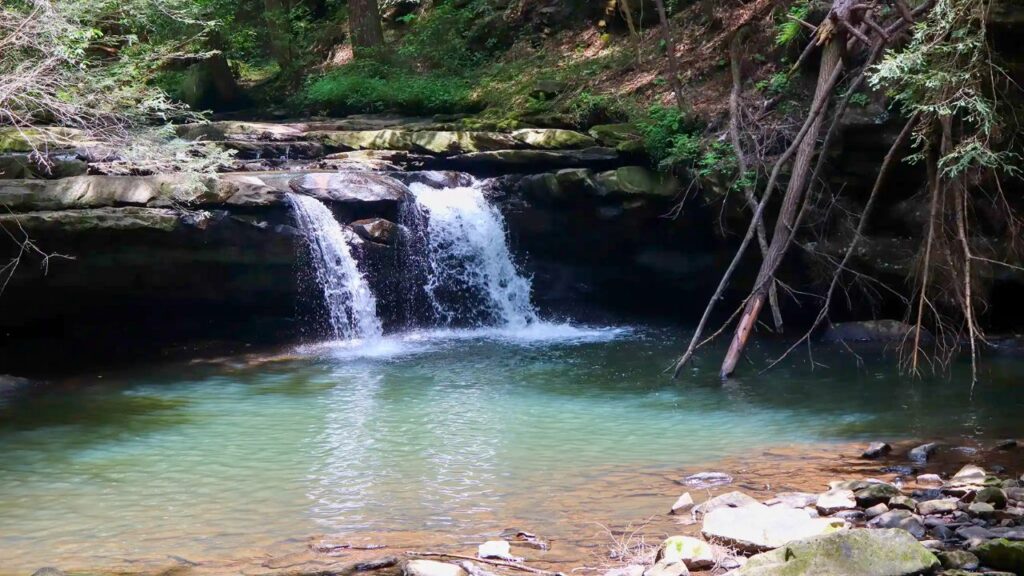
- Seasonal Spectacle: Located in the Sycamore Canyon Wilderness near Williams, Sycamore Falls is a majestic, 100-foot seasonal waterfall. It typically flows best during the spring snowmelt or after significant monsoon rains.
- The Hike: Reaching it involves a moderate 6-mile hike (one way), often requiring navigation skills as trails can be less defined in wilderness areas.
- Check Conditions: Always check recent rainfall or snowmelt conditions before attempting this hike, as the falls can be dry much of the year.
Waterfalls of the Salt River Canyon
East of Phoenix, the Salt River Canyon offers dramatic scenery and powerful waterfalls, accessible with permits from the White Mountain Apache Tribe.
1. Cibecue Falls
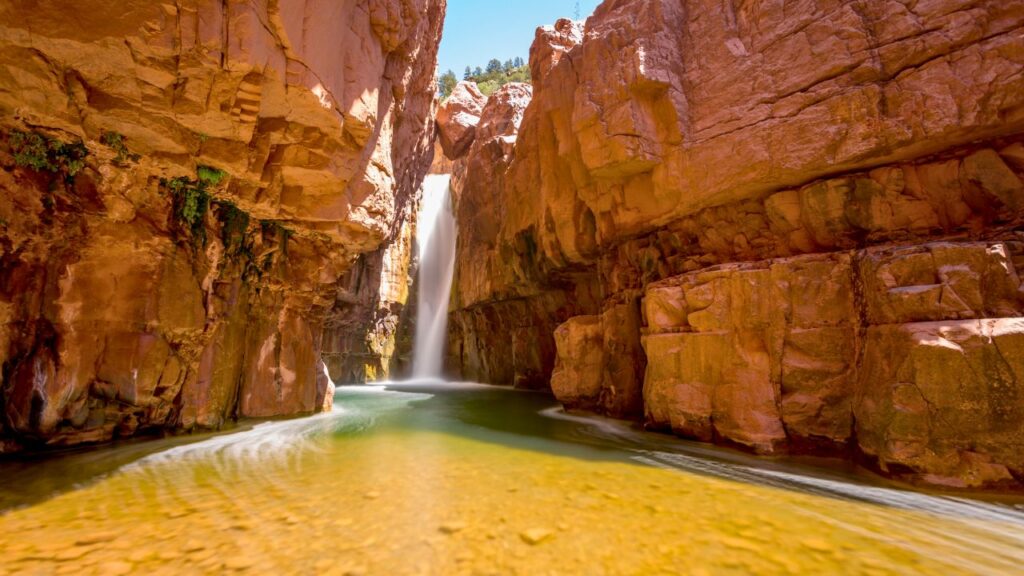
- Canyon Gem: This hike is an adventure! You’ll trek up the Cibecue Creek, often wading through the water, to reach a stunning 40-foot waterfall plunging into a deep emerald pool surrounded by sheer canyon walls.
- The Hike: It’s a moderate 4-mile round trip, but the water hiking adds a unique challenge and fun factor. Water shoes are essential!
- Location: Near Globe, Arizona.
- Permits Required: You must purchase a permit from the White Mountain Apache Tribe before your hike.
- Wow Factor: Emerging into the natural amphitheater where Cibecue Falls resides feels like discovering a secret sanctuary.
2. Apache Falls
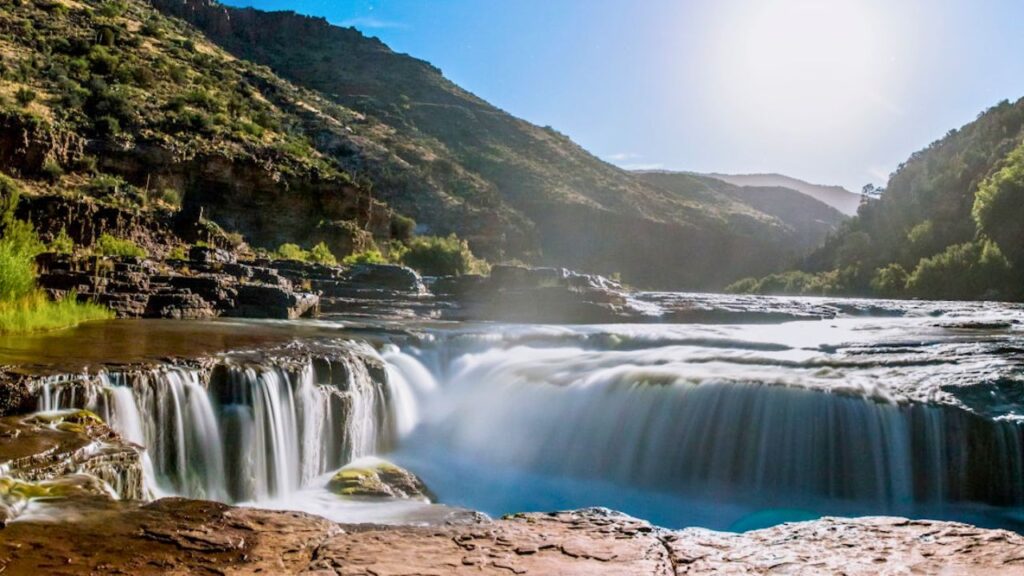
- Easy Access Cascade: Close to Cibecue Falls (and requiring the same permit), Apache Falls is much easier to reach. It’s a broad series of cascades tumbling down into the Salt River.
- The Hike: An easy 1-mile round trip makes it very accessible.
- Perfect Pairing: Many visitors combine visits to both Cibecue and Apache Falls on the same day for a full Salt River Canyon waterfall experience.
Southern Arizona Surprises
Don’t count out Southern Arizona! The “Sky Island” mountain ranges near Tucson hide some unexpected waterfall treasures.
1. Seven Falls
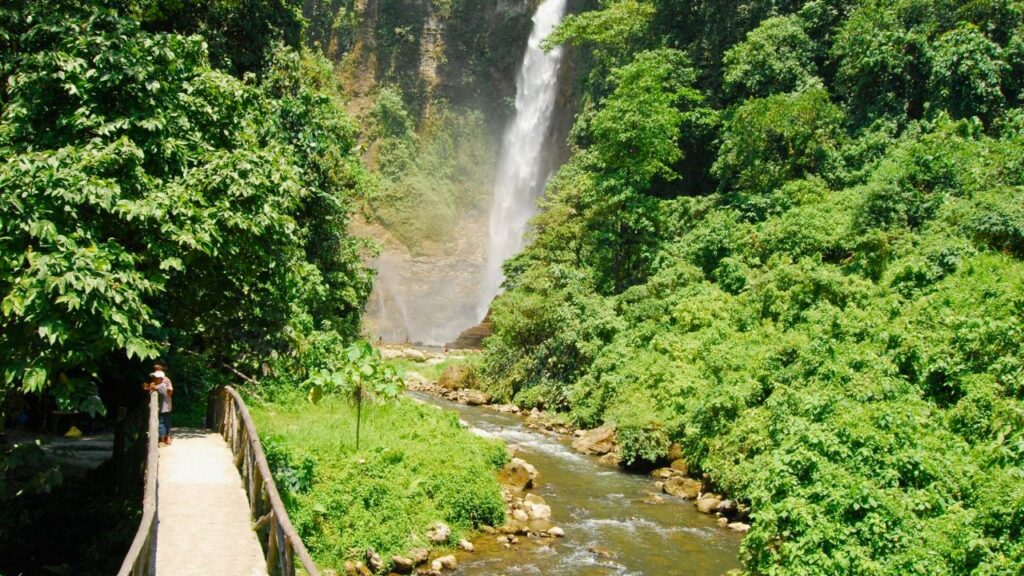
- Sabino Canyon Star: Located in the popular Sabino Canyon Recreation Area near Tucson, Seven Falls is a beautiful series of cascades flowing over smooth granite into crystal-clear pools.
- The Hike: It’s a moderate 5-mile round trip hike (or longer depending on your starting point). You can shorten the walk by taking the fee-based Sabino Canyon Tram partway. The trail involves multiple creek crossings.
- Best Time to Visit: Spring is magical when water flow is highest and wildflowers might be blooming. However, water often flows year-round, though it can be low in dry periods.
- Family Favorite: Its relative accessibility (especially with the tram option) and beautiful pools make it a hit with families.
2. Tanque Verde Falls
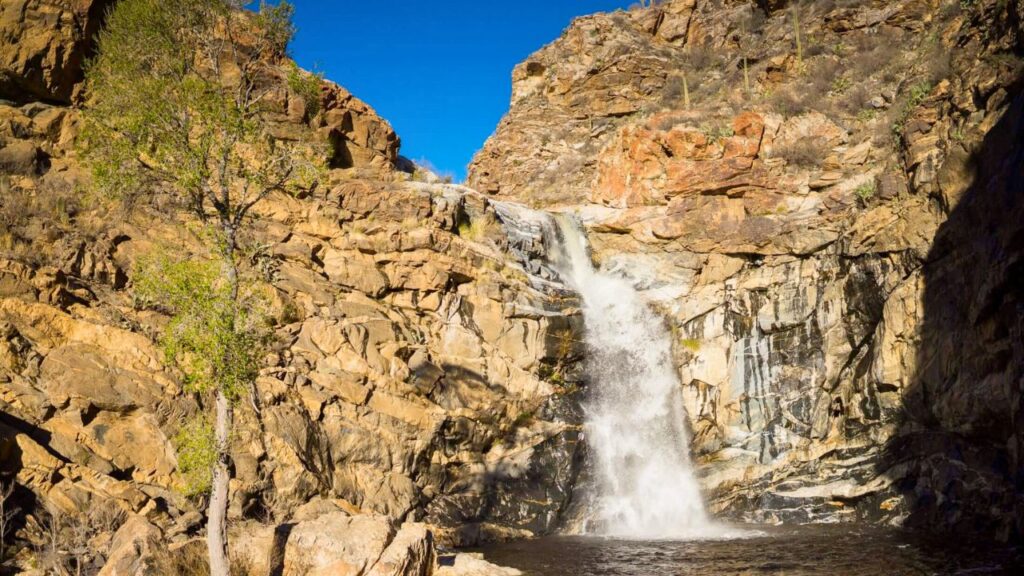
- Rugged Beauty: East of Tucson, Tanque Verde Falls offers a more rugged experience. The trail leads to an impressive 80-foot main waterfall, with numerous smaller pools and cascades along the way.
- The Hike: A moderate 1.6-mile round trip, but it involves some rock scrambling and navigating over potentially slippery surfaces. Use caution.
- Desert Oasis: It’s a fantastic example of how water carves its way through the desert landscape, creating unexpected swimming holes.
3. Romero Pools
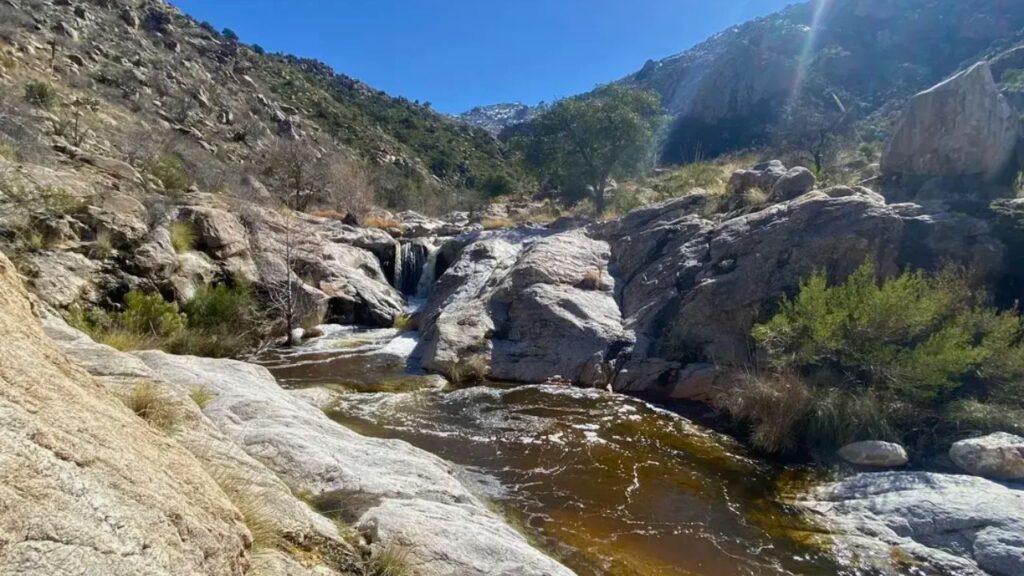
- Desert Meets Water: Located in Catalina State Park near Tucson, the hike to Romero Pools takes you through classic Sonoran Desert terrain before reaching a series of seasonal pools and small waterfalls nestled in a rocky canyon.
- The Hike: A moderate 5.6-mile round trip with some elevation gain.
- Seasonal Flow: Water levels are highly dependent on recent rainfall. Check conditions before going, especially during dry seasons.
Remote & Grand Scale Falls
These require more effort or specific timing but offer immense rewards.
1. Grand Falls
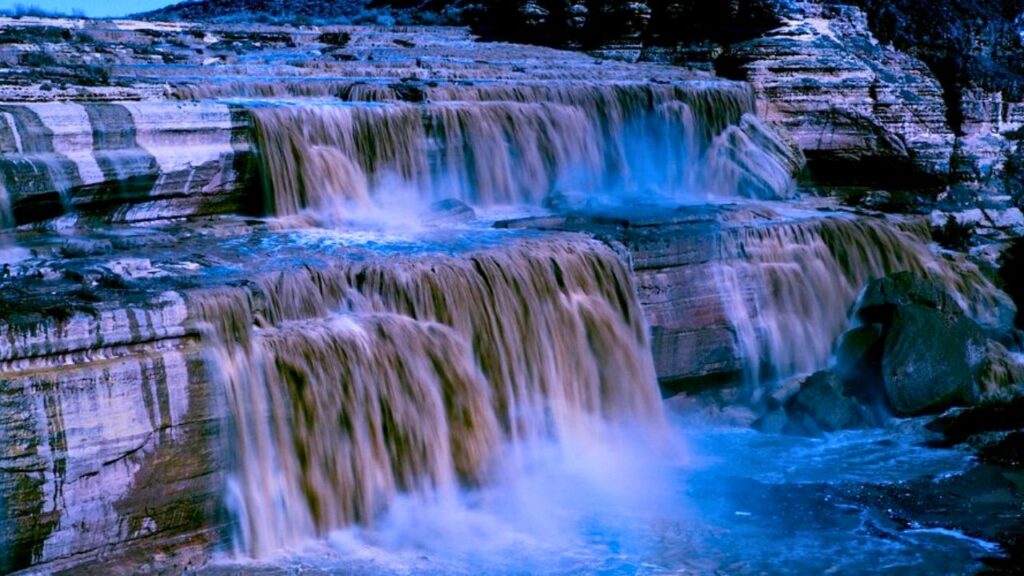
- The “Chocolate Falls”: Taller than Niagara Falls, Grand Falls is a wide, powerful waterfall on the Little Colorado River located on Navajo Nation land. It’s known for its muddy appearance, especially during peak flow, earning it the nickname “Chocolate Falls.”
- Timing is Everything: It flows strongest during the spring snowmelt (typically March-April) and sometimes after heavy summer monsoons. Much of the year, it can be just a trickle or completely dry.
- Access: Requires driving on unpaved roads. Check road conditions, especially after rain. No significant hiking is required to view the falls from the overlook.
2. Deer Creek Falls
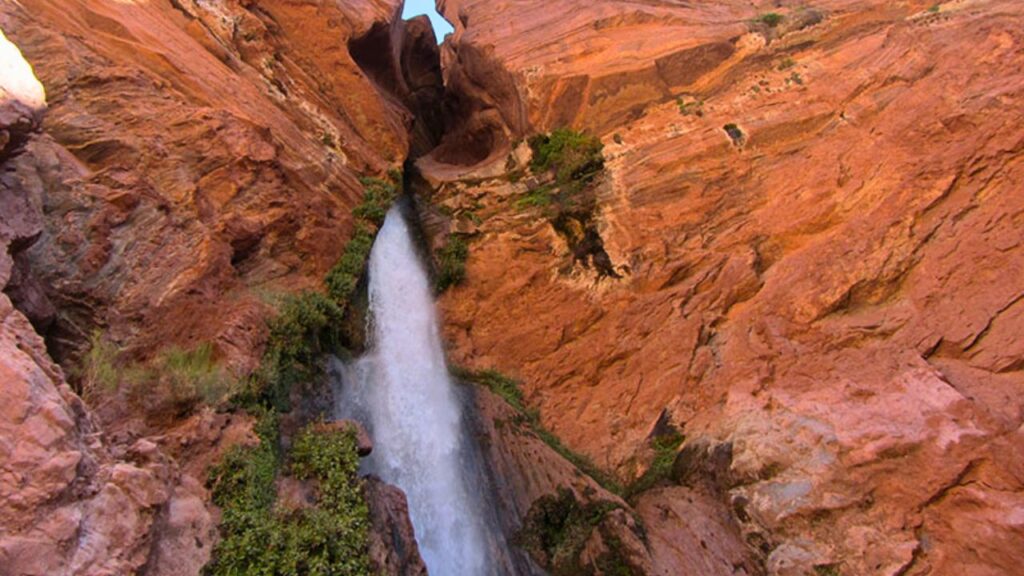
- Grand Canyon Rafting Gem: While technically accessible via a very strenuous multi-day backpacking trip, Deer Creek Falls is most commonly experienced as a stop on Colorado River rafting trips through the Grand Canyon. It’s a stunning ribbon waterfall plunging directly into the mighty Colorado River near a narrow slot canyon.
- The Hike (Short): From the river, a short, moderate hike leads up into the sculpted narrows carved by Deer Creek.
Planning Your Arizona Waterfall Adventure
- Check Water Flow: Many Arizona waterfalls are seasonal. Always check recent conditions, snowmelt reports, or call local ranger districts before heading out, especially for falls outside of Havasupai or Fossil Creek.
- Permits: Be aware that many popular waterfalls (Havasupai, Fossil Creek, Cibecue/Apache, Pacheta Falls, Grand Falls area) require permits obtained in advance. Research permit requirements thoroughly.
- Best Times: Spring (March-May) is often ideal due to snowmelt increasing flow and milder temperatures. Fall (September-November) can also be pleasant. Summer (June-August) brings extreme heat to lower elevations and the risk of flash floods during monsoon season (mid-June through September).
- Safety:
- Hydration: Carry MORE water than you think you’ll need, especially in summer. Heatstroke is a serious risk.
- Footwear: Sturdy hiking boots are essential for rocky trails. Water shoes are highly recommended for hikes involving creek crossings (Cibecue, Seven Falls).
- Sun Protection: Wear hats, sunglasses, and sunscreen. Shade can be limited on many trails.
- Flash Floods: Be extremely aware of weather forecasts, especially during monsoon season. Canyons can flood rapidly and unexpectedly. If rain threatens, seek higher ground immediately.
- Navigation: Download offline maps or carry a physical map and compass, especially for less-maintained trails.
- Leave No Trace: Pack out everything you pack in, stay on marked trails, respect wildlife, and minimize your impact on these beautiful natural areas.
Arizona’s waterfalls offer a magical contrast to its desert reputation. From the world-renowned cascades of Havasupai to hidden gems tucked away in canyons, these hikes provide adventure, beauty, and a refreshing connection with nature. So grab your boots, pack plenty of water, and get ready to chase some waterfalls!
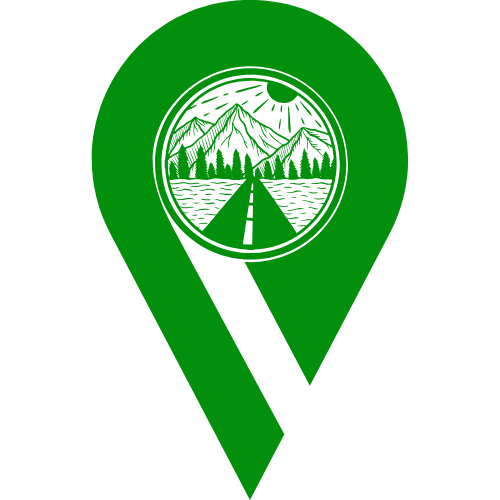
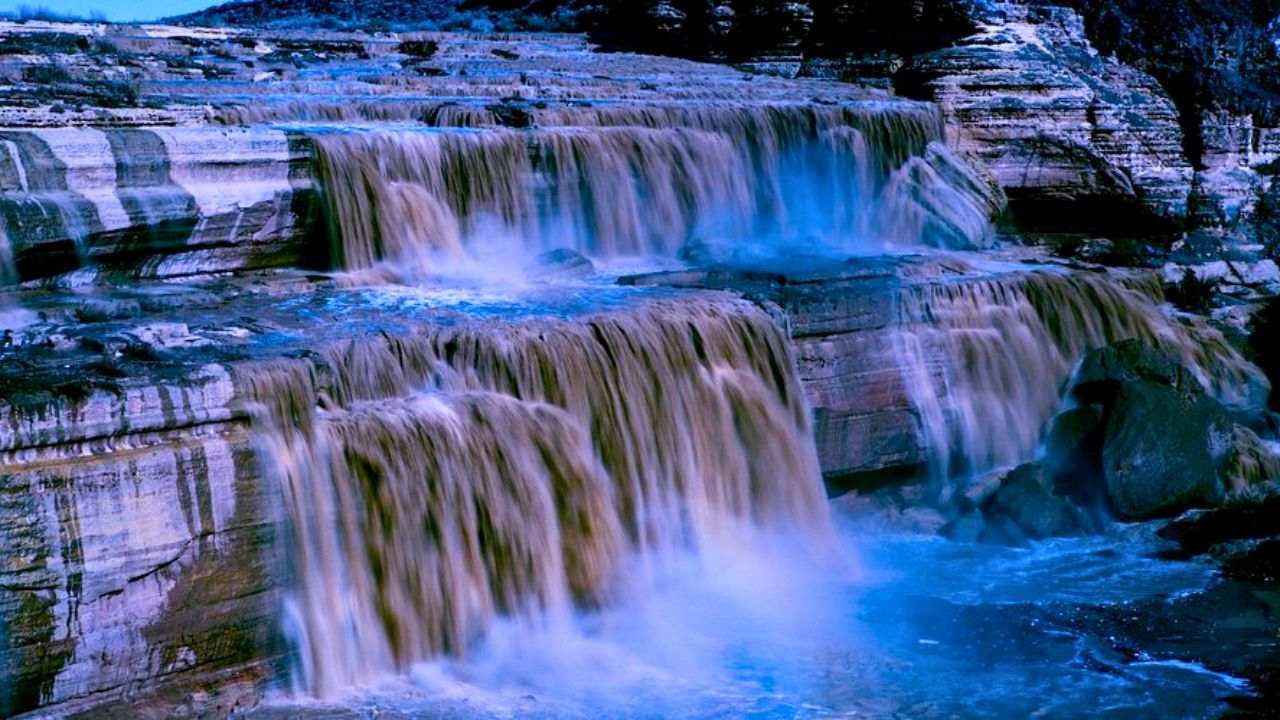
Leave a Reply